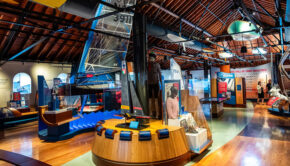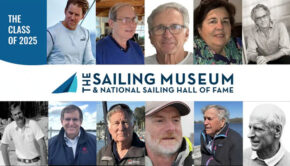Robbie Doyle: On the shoulders of giants
Published on November 17th, 2019
Since its launch in 2011, the National Hall of Fame has enshrined 81 heroes of the sport, with its induction ceremonies offering an opportunity to witness these outstanding individuals. The Class of 2019 was the ninth such occasion, with Robbie Doyle among the latest inductees. Here was his acceptance speech:
This is truly a humbling experience. There’s no other way to put it. To see all the inductees, and to now include myself in that group, I honestly felt I was Forrest Gump, sort of stumbling through life and events as an observer, sort of real but not real, and it was a nice feeling.
My stumbling started right in my own neighborhood of Marblehead where I came across the likes of Ted Hood, George O’Day, Ray Hunt, and Dave Curtis. They were just guys who hung around the yacht clubs and sailed. As soon as I ventured outside Marblehead, I came across the likes of Lowell North, Peter Barrett, Ted Turner, Olin and Rod Stephens, Gary Jobson, Tom Whidden, Bob Johnstone, Buddy Friedrichs, The Harken brothers, Dennis Conner, and many more.
Of all these, the person who perhaps had the most influence on me, and sucked me into the industry and my love of sailing, was Peter Barrett. His warm personality and true love of sailing, and the science behind it, was very inspiring to me. People said about Pete Barrett, he always was on a broad reach. There’s no other way to describe that smile. And, of course, the person that kept me working the hardest is Tom Whidden. When are you going to retire?
Reading the Hall of Fame essay about me, it seems I accomplished more by the time I was 32 than I have since. Hopefully, that’s not the case. But one thing is true, as my wife Janet has famously said, “The older we get, the better we were.” Ted Turner once said – he’s known for a lot of statements – “If I were a bit more humble, I’d be perfect.” That’s not my story, but there is another saying by Sir Isaac Newton, “I can see farther because I stand on the shoulders of giants.”
Well, my association with the likes of Lowell North, Ted Hood, and Ted Turner certainly helped me see further.
My success is based on standing on the shoulders of those around me. This starts with my wife, Janet, who has been vital to my accomplishments going all the way back to my Olympic campaign 1968, long before we married. She put together the sweatshirts so I could carry 150 pounds of wet clothing on my back to be able to compete with the big guys. I weighed all of 148, and that was on a good day.
Many of my sailing achievements for which I have been credited, such as Maltese Falcon, Mirabella V, and Sailing Yacht A, I could not have achieved without the engineering help and CFD work of my son Tyler. Financially, I’m only on solid ground because of the help of my son, Ethan. And my daughter, Jennifer, is the one who kept me humble.
How many 60-plus-year-old fathers have to do handstand contests in their front yard to prove their worth? My children have also served me extremely well, sailing with me in some very successful world championships.
There’s another quote that is perhaps the driving course in my life, “Where there’s a problem, there’s an opportunity.” Reggie Cole, long-time professional captain, says it a bit differently, “We don’t have a problem. We have a situation that needs to be resolved.” Reggie is one of those people whose confidence in me has allowed me to accomplish much. And with, frankly, the Shockwave and Proteus programs, we have had many situations.
In addition to Reggie, there are three others in the room whose shoulders I’ve stood on. Chris Gardner was the captain of Maltese Falcon when their rig concept was put together, and it went perfectly, didn’t it Chris? Gary Jobson, who I’ve had the pleasure of sailing with and trying to make his tactics look better. And LJ Edgcomb who has bailed all of us out of a lot of situations as bowman, and this past summer as navigator.
I think Gary and LJ concur that my son Tyler’s CFD work, designing a new trim tab for Courageous, made us all look a little better than we were this past summer, particularly in the North Americans.
There are many more key people including owners and naval architects who put their faith in me, and continue to do so even when early executions often were far from perfect.
For Chuck Kirsch, long-time owner of the Scaramouches and America’s Cup representative, I can remember building the first Kevlar main for any offshore boat ever. It was five ounce cloth because my boss Ted Hood said, “Using anything more than that is a waste of weight.” And we go sailing, and two hours later, the thing explodes. Chuck says, “I think the next one should be a little heavier, you know?”
And other people like Jim Kilroy who ordered his first sails from us before our loft is even finished being built. Bill Johnson, owner of Windward Passage, ordered a whole inventory shortly after. It was not long before we got a call from William Simon to build sails for his 125-foot S&S Freedom because Olin thought I could do a good job.
And not long after that, I literally bumped into Tom Perkins on an airplane. I was fiddling around, trying to do some work on the sail plan, and he looked over. He says, “What’s that? It looks like a sailboat. I’ve got a sailboat and have some sails I’m not very happy with. Maybe you could build some sails for my boat.” And I said, “Sure.” I said, “How big is it?” He said, “147 feet.”
That meeting, by chance, led to building sails for the 147-foot Andromeda La Dea and a long-term friendship with Tom, which Chris and I share. And then leading up to the 289-foot Maltese Falcon, where we put that DynaRig together…that was quite an adventure and quite a success, but there was were some ups and downs.
But even before Maltese Falcon sails were complete, I got a call from Joe Vittoria who wanted to build the sloop like I’d never been built before – the 250-foot Mirabella V with a 300-foot mast. Now, to put this in perspective, that mast is about twice the height of a J Class mast. How’d I answer? “Yeah. No problem.” So he went on to build the boat and we got to work.
This ultimately led to us building sails for the next biggest sloop, which is the 200-foot Perseus Cubed, which led us to building what is still the world’s largest sail, their 28,000 square foot A2 spinnaker. This was soon followed by the world’s largest sailing yacht, Sailing Yacht A. Three free-standing rigs, mainsails bigger than Mirabella Vs that had to go up and down on roller boom. No problem.
Finally, one of my most challenging projects was not in the world of sailmaking, but it was solving New York’s Culture Shed dilemma of needing 14 blackout curtains that also completely insulated it from sound, both in going out, and out going in. Each curtain was about 3,000 square feet and weighed 18,000 pounds, and they had to unroll and roll over a waterfall-type projection in under two minutes.
Two other large contractors had failed previously, and thus, we had less than half the time that was budgeted, but somehow, it came together. We had become the go-to for an unsolvable problem-type industry or situations, as Reggie would say.
But none of these projects could have been accomplished without an incredible team of engineers with sailmaking talent around me. I mostly tell them, “No problem. Just an opportunity.” I feel very fortunate to be here today, and I do so standing on the shoulders of those that supported be, and despite what the essay says, I don’t think I’m done.
In closing, I think of a scene from Sound of Music where Julie Andrews asked Sister Superior, “What should I do with my life?” and she says, “You should live it as if it was meant to be.” I think I’ve done that. Thank you very much.









 We’ll keep your information safe.
We’ll keep your information safe.